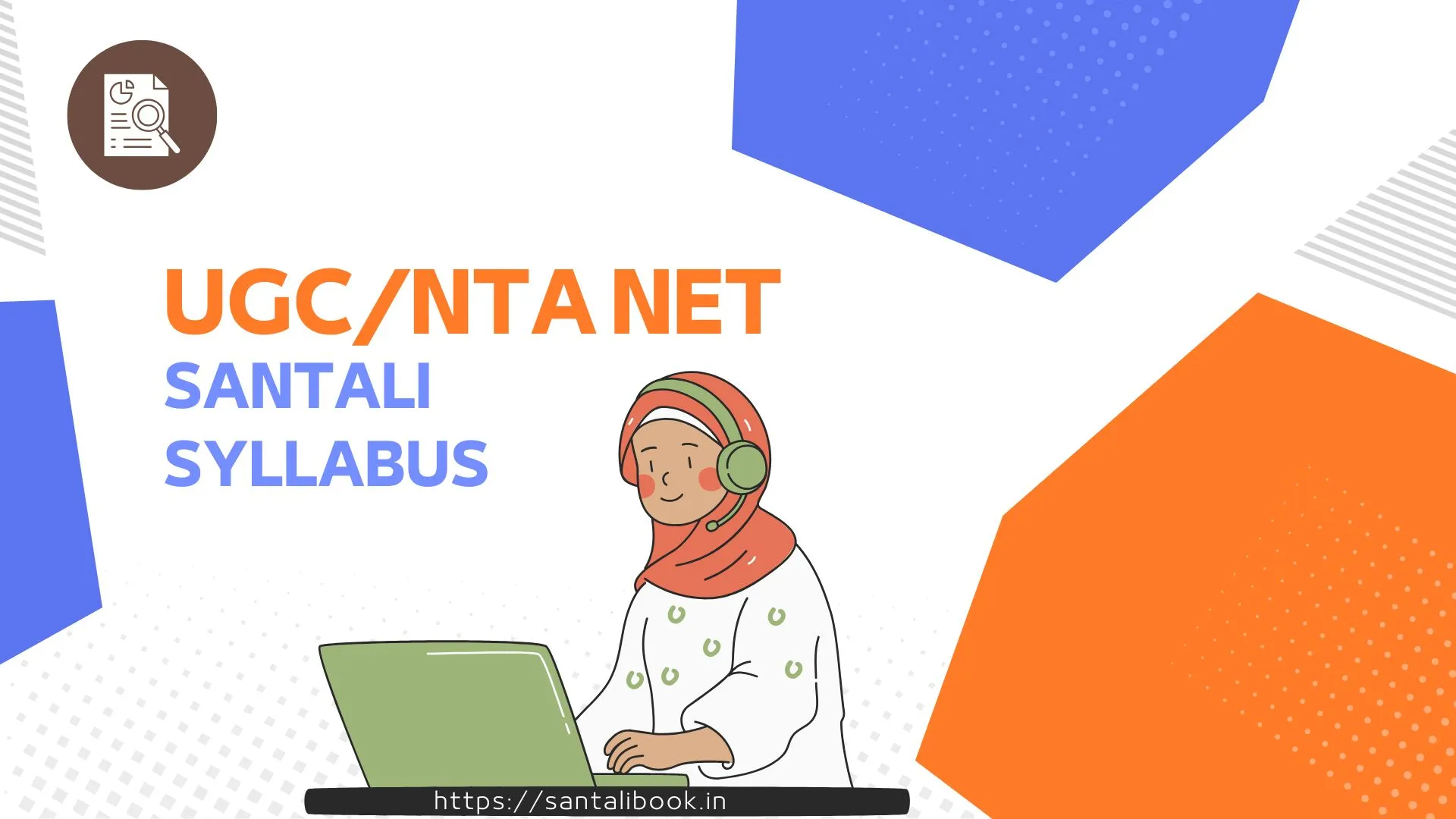SANTALI SUBJECT Code No-95
The UGC NET syllabus for Santali in 2025 is part of the broader UGC NET framework, which consists of two papers: Paper 1 and Paper 2. Here’s a detailed overview:
UGC NET Syllabus Overview
Paper 1
This paper is common for all candidates and assesses general teaching and research aptitude. It includes the following key areas:
- Teaching Aptitude: Understanding of various teaching methods and learner characteristics.
- Research Aptitude: Basics of research, including types, characteristics, and ethics.
- Comprehension: Ability to interpret written texts.
- Communication: Effective communication strategies and barriers.
- Mathematical Reasoning: Basic problem-solving and data interpretation skills.
- Logical Reasoning: Analyzing arguments and solving logical puzzles.
- Information and Communication Technology (ICT): Role of technology in education.
- People, Development, and Environment: Social issues and environmental concerns.
- Higher Education System: Overview of the higher education landscape in India.
Paper 2 (Santali)
The syllabus for Santali specifically includes:
- Language Proficiency: Understanding of Santali grammar, vocabulary, and syntax.
- Literature: Study of Santali literature, including major authors, poets, and literary movements.
- Cultural Context: Exploration of the cultural and historical significance of the Santali language and its speakers.
- Translation Skills: Ability to translate texts between Santali and other languages.
For detailed topics under each subject area, candidates should refer to the official UGC NET syllabus document or specific resources dedicated to the Santali subject.
Exam Format
Both papers are conducted in a computer-based test format:
- Total Questions: Paper 1 has 50 questions; Paper 2 has 100 questions.
- Marking Scheme: Each correct answer earns +2 marks with no negative marking.
Candidates preparing for the UGC NET should ensure they are familiar with both the general syllabus for Paper 1 and the specific requirements for Paper 2 in Santali to enhance their chances of success in the examination.
विषयः-संताली पारसी-साँवहेंत् (संताली भाषा-साहित्य )
नोट:-
A. संताली भाषा-साहित्य पाठ्यक्रम रे दो बारया कुकली साकाम ताँहेंना। कुकली साकाम ॥ आर कुकली साकाम III, कुकली साकाम ॥ रे दो 50 गोटाङ आडीसाँगे बहुविकल्पी’ कुकली ताँहेंना (आडी लेकान बाछनावा, मित् लेकाना, सारी/एड़े मेन, ठावका, ओजेः) जाहाँ रेनाङ गुट एलेख 100 अंक ताँहेना। कुकली साकाम III रे दो 75 गोटाङ आडीसाँगे बहुविकल्पी कुकली ताँहेंना (आडी लेकान बाछनावा, मित् लेकाना, सारी/एड़े मेन, वावका, ओजेः) जाहाँ रेनाङ गुट एलेख 150 अंक ताँहेना।
B. कुकली साकाम ।। आर कुकली साकाम ।।। रेयाक् कुकली को दो देवनागरी (आखोर) तेगे ओल ताँहेंना। लानाईको दो संताली पारसी देवनागरी (आखोर) तेगे ओल हुयूक् आ।
1. जाति विज्ञान
1. मानवविज्ञान आर जात सांड़ेस रेयाक लायारी आर मुढ़ान
ii. पाड़हाय ठाँव
iii. पाड़हाव आरी
iv. पाड़हाव रेयाङ जोस
v. आसोल डारको
vi. लाकतीको
vii. एटाक् जिनितको साँव जोनोड़ाव आर गुन
viii. निताङ बेभहार,
ix. आरीचाली रेनाङ उड़हार आर आरूफेराव
x. आदिमकोवाक साँवता व्यवस्था
xi. आदिमकोवाक् कावडी व्यवस्था
xii. आदिमकोवाक् घोरोम व्यवस्था
xiii. झारखण्ड, पछिमबंगला, असाम, बिहार, उडीसा आर सुरसुपुर पोनोत कोरेन आदिम आर सादान कोवाक् जातसाँडेस पाड़हाव।
2. सामान्य भाषा विज्ञान
पारसीसाँडेस रेनाक् लायारी आर नोवा रेनाक हाटिञ
li पारसीसाँडेस रेनाङ पाड़हाव ड़ारको
पारसी ओमोनोमः रेनाक् सिद्धान्त
iv प्रासी रेनाङ गुनान आर परकिति
पारसी रेनाङ उथनाव, आक्रूफेराव आर ओना रेनाङ ओजे
vi पारसी रेनाङ भिना-मिना मुठान
vii पारसी रेनाङ हाटिञ
vili साडसाँडेस
ix रूपसाँडेस
X मानेसाँडेस
xi आयातसाँडेस
xii आखोर साँडेस
xiii साबादमुराई साँडेस
xiv सानतााड़ी रेनाङ पारसी साँडेस पाड़हाव
XV जेगेत् पारसी घारोञ्
3. संताली व्याकरण
i. आडाङ आर आखोर
ii. साबाद बेनाव
iii. पारसी रेनाङ गुनान
iv. जुनुम
v. उजीनुम
vi. जानाङ
vii. जोना
viii. गोटाङ
ix. कामवा
x. নাজ
xl. गुनुम
xii. लागिया
xiii. जेनेलेत्
xiv. जिवीयान आर बेजिवीयान
xv. अग्नेय पारसी घारोञ्च।
4. साहित्य सिद्धान्त
1. साँवहेत् रेनाङ लायारी आर नोवा रेनाक् गुनको
ii. सॉवहेत् रेनाङ तेतेत्
a) विषय
b) भाब
c) परिवेस जागाव
d) पारसी
e) उनुइहार
f) ओनोड़हें रूप रेयाक् बुनयाद
9) आडीलेकान ओनोड़ों रूप
h) सेरेञ
i) तारा ओनोड़हें
J) लाटू ओनोड़हें
k) काहनी
1) गायान
m) गामाम
n) ओनोल
०) मित्किता गायान
p) साँवहेत् रेनाङ लाकती
१) साँवर्हेत् रेनाङ ओजे
r) साबाद दाडे
s) रोस रेनाङ हाटिञ
1) साजावनाकों
५) छांदाव
III. होड़ साँवहेंत् ‘लोक साहित्य’
a. लायारी
b. पाड़हाव रेनाङ टोठा
c. मोहोत
d. पाड़हाव रेनाङ आरी
e. होड़ काहनी रेनाङ आडीलेकान रूप
f. मिथ
g. लीजेण्ड
h. होड़ सेरेज रेनाङ आडी लोकान रूप
1. लेगनेमाचार सेरेञ
j. गिदरा बावली
k. पाराब पुनाई सेरेञ
1. बापला सेरेञ
m. लाय आगू काथा
n. भेन्ताकाथा
०. कुदुम
5. भारतीय साहित्य
i. सेदायाक्, तालावाक् आर निताक भारतीय साँवहेत्
a. वेद
b. उपनिषद्
c. महाकाव्य
d. रामायण
e. महाभारत
f. गीता
II. हिन्दी साँवहेंत् रेनाङ खाटो उनुरूम
iii. बंगला साँवहेंत् रेनाङ खाटो उनुरूम
iv. पाछिम दिसोम साँवहेत् रेनाङ खाटो उनुरूम
6. संताली गाथनी
a. संताली साँवर्हेत् रेयाक ओमोनोम आर हारा
b. संताली होड़ सेरेञ रेनाङ गुनको
c. सेरेञको रेनाङ हाटिज हापाटिञ,
d. संताली ओनोड़हिंया आर संताली, ओनोड़हें
e. नाहाक् संताली सेरेञ
7. संताली काथनी
A. संताली होड़ काहनी / काथा रेनाङ गुनको
B. काहनी / काथा को रेनाङ हाटिन/हापाटिञ,
C. संताली काहनी ओनोलिया आर संताली कहानी को
D. संताली गामाम ओनोलिया आर संताली गामाम
E. संताली ओनोल ओनोलिया आर संताली ओनोल
F. संताली गायान ओनोलिया आर संताली गायान
G. संताली तुलाजोखायिया आर तुलाजोखा सावहेंत्
H. संताली पाथाम सासापड़ियाको आर संताली पाथाम
Click for PDF Download
